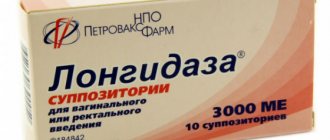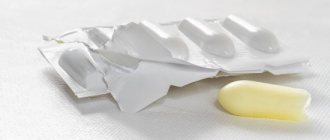Typically, the drug Longidaza is prescribed for endometriosis and has quite good reviews. Endometriosis is a female disease. It is due to the presence of healthy endometrial tissue outside the uterus. The endometrium is the inner lining of the uterus, consisting of glands and stroma, and is shed during menstruation. Sometimes the endometrium can spread beyond the uterine cavity, where it also undergoes cyclic transformations. In this case, inflammatory reactions begin to develop at the site of the presence of the endometrium. There is also a possibility of adhesions and scars.
About the disease
Microbleeding may form in the areas. The danger with the disease is that a woman cannot become pregnant. It is also accompanied by frequent or constant pain, is exhausting and has a negative effect on the mental state.
Similar lesions outside the uterus are located in the pelvic area. Initially, they manifest themselves as noticeable pain during menstruation, as well as constant pain in the pelvic area. This pathology is dangerous for infertility.
At the first symptoms of endometriosis, you should immediately consult a specialist. The doctor will examine you and prescribe the best treatment option.
Symptoms
Signs of deviation will be:
- Regular pain several days before and after menstruation.
- Pain during menstruation.
- Pain in the lower abdomen and groin area.
- Pain during urination and physical activity.
- Unpleasant sensations during sexual intercourse.
- Heavy periods.
- The duration of menstruation is more than 8 days.
- Short cycle length (less than 27 days).
- There may be tension in the cyst, which is not felt during menstruation.
- Symptoms weaken or disappear altogether during pregnancy or lactation.
Most often, no abnormalities or symptoms are visible externally.
Also, during examination of the pelvis, it is possible to detect space-occupying formations.
Diagnosis methods
The diagnosis is made based on characteristic clinical manifestations. It is also confirmed by the following, both instrumental and laboratory observation techniques:
- Ultrasound observation of the pelvic organs. Allows you to identify the area of location, size and characteristics of the center of inflammation.
- Hysteroscopy. Makes it possible to show changes in relief in the area of the uterine cavity, and also shows whether scars are present.
- MRI of the pelvic organs. It is considered the most informative way of research. It also provides more accurate observation of the location and structure of endometriosis.
- Laparoscopy. This method is the most reliable in confirming the diagnosis.
Longidaza after laparoscopy for fallopian tube obstruction - reviews
The drug Longidaza is a widely used drug in many areas of medicine and even cosmetology. It is available in two types:
- solution for preparation of injections;
- rectal and vaginal suppositories.
Both forms of the medicine help the substance to be absorbed instantly throughout the body through the blood. Longidase is excreted naturally through the human liver and kidneys.
Applications of Longidase
Longidaza is widely used in many areas of medicine. These include:
- traumatology;
- diseases of the joints, musculoskeletal system;
- urology;
- gynecology;
- haemorrhoids.
Longidase treatment is quite long; the doctor prescribes a course of taking the drug for up to one month. Longidaza is especially good to use at the initial stage of the disease - it is at these moments that its effect is most powerful.
The composition of Longidase is capable of solving problems such as the breakdown of proteins in the body, resorption of hematomas, healing of scars, and improvement of joint function. The drug is also used in cosmetology to combat ulcers, scars, and skin rashes.
Reviews from patients speak for themselves - if you use the drug correctly and follow the advice of your doctor, the positive effect will not be long in coming.
Longidaza in gynecology
Longidaza can be prescribed by a doctor to a female patient for the treatment of diseases associated mainly with infertility, as well as as a restorative procedure after various technological methods that are used in gynecology to examine and study the condition of the uterus and fallopian tubes.
Longidase treatment in gynecology is often performed using a technique called electrophoresis. Electrophoresis is a method based on the use of electrical impulses. With its help, medicine can be introduced into the human body without injection, without the use of gels. In some ways it is similar to the laser method of introducing a substance into the body.
So, before electrophoresis, the doctor collects the patient’s medical history, questions her about complaints and performs a general clinical examination. Next, the woman lies on her stomach, and contacts are applied to individual areas on her back, which will conduct electrical impulses into the body. With their help, the medicine will be introduced into the body.
This technique is not only a method of introducing medicine into the body, but a kind of research that can detect anomalies in the following areas:
- renal failure;
- infectious and inflammatory processes;
- serious liver diseases;
- oncological diseases;
- autoimmune disorders.
The electrophoresis method was discovered at the very beginning of the twentieth century and very soon gained recognition. It is used everywhere in our time.
In general, a woman’s visit to a gynecologist is almost always accompanied by certain worries and concerns, since, in addition to her own health, her family may also suffer from her gynecological condition; this may affect the absence of children.
About ten percent of women around the world experience some problems conceiving a child. They are often resolved by technological intervention, such as laparoscopy. A technique such as laparoscopy is used for obstruction of the fallopian tubes. Longidaza after laparoscopy is used as a restorative agent that consolidates the result obtained after curettage.
Blockage and obstruction of the fallopian tubes is one of the pathologies that leads to tubal infertility. Medicine does not stand still and is constantly improving, so tubal infertility is successfully treated these days.
Laparoscopy was first tested in 1901 on a dog. Through a hole in her abdomen, she was examined and clinically analyzed. After 10 years, laparoscopy has become a technique suitable for humans.
Throughout the twentieth century, laparoscopy was constantly improved, cameras and optical lenses were added. Engineers from all civilized countries of the world, including our domestic scientists, took part in its “upgrade”.
Today, of course, laparoscopy is considered a surgical intervention, as before. It is quite effective in its effect on the treatment of gynecological diseases associated with infertility.
Endometriosis
For endometriosis, the drug Longidaza is also prescribed. Endometriosis is a female gynecological disease.
The endometrium is healthy uterine tissue that is the inner lining of the uterus. Endometriosis is a kind of inflammation that indicates that the endometrium has grown outside the uterus. Inflammatory processes begin, which may be accompanied by bleeding. This, of course, affects the woman’s mood, causing pain.
Endometriosis is a disease of the pelvic area, which is first accompanied by wild pain during the menstrual cycle due to tissue rejection, and then for reasons unknown to anyone.
At the first symptoms you should consult a doctor. Treatment of endometriosis will be effective if it is started in the initial stages of the disease.
Endometriosis is dangerous because it can cause infertility in a woman, which will be much more difficult to cure.
Symptoms of endometriosis are:
- severe pain for several days before and after the menstrual cycle;
- pain during urination;
- pain in the pelvic area during physical activity;
- pain during sexual intercourse with a partner;
- increased duration of the menstrual cycle or, conversely, its shortened duration;
- constant pain in the lower abdomen, pelvic area and groin.
When diagnosing endometriosis, methods such as:
- Ultrasound of the pelvis;
- MRI of the groin and pelvis;
- laparoscopy.
It must be said that laparoscopy in this regard is the most effective diagnostic method.
Treatment of endometriosis involves both the use of folk remedies and the use of medications, including the drug Longidaza.
Mastopathy
Longidaza is also actively used for such female diseases as mastopathy. With mastopathy, too many hormones are produced in the mammary glands, so the disease has either a pronounced hormonal or extragenital character.
The pathology is associated with the proliferation of cells in the mammary glands and connective tissues. The drug Longidaza prevents this by destroying pronounced growths.
It is worth noting that only mature women of reproductive age are susceptible to mastopathy.
Pathologies of the mammary glands can arise from diseases of other organs, including, for example, the liver.
Symptoms of mastopathy are as follows:
- pain and swelling in the mammary glands;
- nipple discharge;
- constant pain in the chest;
- increase and worsening pain during menstruation;
- progression of the disease in symptomatic terms, that is, the symptoms of mastopathy are constantly increasing.
At the first stage of the pathology, a woman may not notice any abnormalities at all, so it is important to perceive pain in the mammary glands not as a common thing, but as the beginning of possible abnormalities, and consult a doctor.
Diagnostic methods for detecting mastopathy are ultrasound of the mammary glands and mammography, and treatment methods include the use of Longidase and other drugs that reduce the severity of cell proliferation in the mammary glands and excessive production of hormones.
Uterine fibroids and other gynecological diseases and longidase
For uterine fibroids, your doctor may also prescribe the drug Longidaza. Uterine fibroids as a pathology are quite common in women; it is a benign formation that grows on the muscle of the uterus. These foreign bodies can be very large in size, and the reasons for their appearance, by the way, have not yet been fully studied. Of course, fibroids are hormonal in nature, but the root causes are unknown to science.
When treating uterine fibroids, doctors resort to surgery to remove and enucleate some nodes or the uterus itself.
Longidaza can reduce symptoms of fibroids.
The drug is also prescribed for pain indicating the presence of cystitis, after HSG (hysterosalpingography) and thrush, as well as after lip surgery and rhinoplasty.
Longidaza is also useful as a restorative procedure after hysteroscopy, a method of visual clinical examination of the uterine cavity using a hysteroscope.
cosmetologo.ru
Treatment
The choice of method depends on the severity of the pathology and the patient’s condition.
Possibility of treatment at home
Endometriosis, of course, should be treated under the close supervision of a doctor. You should also know that our ancestors treated this disease with folk remedies. The most effective of all “folk” methods of disposal is pregnancy.
There are also many other methods of home exposure:
- Herbs;
- Use of leeches;
- Use of clay;
- Treatment with propolis;
- The use of celandine.
As a rule, after an examination, doctors can prescribe both oral contraceptives and progesterone or androgens. Their action is focused on influencing cyclic changes in the endometrium, the main task of which is to stop these changes.
Solving the problem of endometriosis with surgery
Sometimes surgery is used to remove such pathologies. This takes into account the severity of the woman’s complications, her age, and her desire to become pregnant in the future. This influence is divided into:
- Alleviating symptoms (used for patients planning pregnancy);
- Semi-conservative (in this case the possibility of pregnancy is excluded, but the ovaries retain their functions);
- Radical method (remove the organ and appendages completely).
It is worth noting that such an impact in itself is not simple. Surgical intervention is especially difficult for adhesions.
Removal of endometriosis by medication
Drug therapy is used provided there is no mutation in the size of the genital organs, pain, at a young age, in the premenopausal stage.
Solving the problem with the help of medications includes the following types of complex treatment:
- Fighting inflammation;
- Hormonal influence;
- Desensitizing effect;
- Symptomatic effect.
This treatment is based on long-term hormonal therapy, as a result of which disorders in the body are not eliminated, but the work of the ovaries is suppressed. This can cause early menopause, as well as a long absence of menstruation.
Suppositories and tampons for uterine fibroids
Benign tumors occupy a leading place in the structure of gynecological pathologies. One of the common tumor-like neoplasms is uterine fibroids, characteristic of women from thirty to forty-five years old.
Uterine fibroids are manifested by the formation and development of a benign formation in its myometrium. Uterine fibroids do not pose a cancer risk. However, if left untreated, the tumor can reach large sizes, causing bleeding and various disorders of the internal organs.
Myoma has a variety of types:
- diffuse, nodular;
- single, multiple;
- submucosal, subserous, intramural, retroperitoneal, intraligamentary;
- cervical, uterine;
- simple, proliferating, presarcoma;
- on a pedicle, on a wide base.
Myomatous nodes are classified as:
Small nodules usually do not cause severe symptoms. When the tumor reaches a significant volume, the following may occur:
- pelvic pain;
- disorders of the excretory system due to compression of neighboring organs;
- heavy, prolonged periods;
- acyclic bleeding;
- anemia;
- increase in abdominal circumference;
- disorders of reproductive function, expressed in infertility and miscarriage.
Scientists name a family history, surgical interventions on the uterus, hypertension, and excess weight as factors that provoke the growth of fibroids.
Longidase for the treatment of endometriosis
Very often, doctors recommend getting rid of such diseases using Lognidase suppositories. Why exactly them, as well as the composition, methods of use, reviews about this drug will be discussed further.
Application
For many years, Longidaza was produced only in the form of injections. This has often made it difficult to use medication for endometriosis. Today, this drug is also produced in the form of suppositories. Longidaza can be purchased in pharmacies, either with or without a specialist prescription. It should be understood that the drug in the form of injections gives the most noticeable effect. It is because of this that specialists can prescribe injections to cure pathologies. If the effect is carried out using suppositories, then you need to strictly follow the course of treatment and know the specifics of using Longidase in this form. Depending on the specialization, the use of the Longidaza suppository is prescribed according to the instructions below:
- For surgical purposes - one suppository every 2-3 days, used 10 times.
- In urology - one Longidaza every other day for up to 10 applications, then additionally after 3 days for up to 10 applications.
- For gynecological purposes, 1 suppository is used every two days; less often, a special additional administration may be prescribed. Reuse only after three months.
- In dermatology, as well as venereology, it is prescribed to be used, as reviews say, every other day, for up to 15 administrations.
You should know that the use of Longidaza is not recommended and is even prohibited in combination with many other drugs.
Contraindications and side effects
The only side effect can be an allergic reaction to the components of the drug. Contraindications are also indicated:
- Pregnancy.
- Individual intolerance to any drug.
- Oncological diseases.
- Breastfeeding period.
- Age under 12 years.
If kidney function is impaired, suppositories should be taken with extreme caution and under the supervision of a medical specialist.
Also, in combination with anesthetics and antibacterial drugs, the effect of the Longidaza suppository may be enhanced.
Reviews about the drug
Examining reviews written or told by both specialists and patients, it should be noted that such an effect is not as effective as other methods of treating endometriosis. But as a therapy aimed at maintaining a woman’s health, it is quite suitable.
Many of them indicate that they were treated with this drug for endometriosis. All of them underwent a course of treatment, which helped them, but after a certain period of time, the pathology appeared again. Some observed that after taking the drug, after some time, women were able to get pregnant, although before undergoing the course of treatment they could not conceive a child for a long time.
Of course, there are women who had to give up this product due to intolerance to the components. But such cases are isolated.
If we take the general opinion, then Longidaza suppositories, when treated in combination with other methods, are of very high quality for endometriosis.
Source matka03.ru
To understand how the disease occurs, consider the structure of the uterus. The inner surface of the uterus is covered by a mucous membrane - the endometrium. Every month, the endometrium matures so that a fertilized egg can attach to it. If pregnancy does not occur, the layer separates during the menstrual cycle, and this process is accompanied by bleeding.
Particles of the endometrium, along with menstrual blood, can enter the fallopian tubes, abdominal cavity and attach there to the internal organs. In a new place, the endometrium behaves in the same way as in the uterus: it bleeds and is renewed every month. Because of this, the surrounding tissues become inflamed, causing pain and complications.
- intrauterine manipulations: abortion, caesarean section, cleaning of the uterine cavity;
- genital surgery;
- childbirth with complications;
- weak immunity;
- changes in hormonal levels;
- stress and overwork.
- Genital endometriosis affects the pelvic organs: the uterus, ovaries, fallopian tubes, vagina, or external genitalia.
- Extragenital endometriosis received this name because it extends beyond the reproductive system and affects other internal organs: the intestines, bladder, kidneys and even the lungs.
- long and heavy menstruation;
- pain during sexual intercourse and urination;
- menstrual irregularities;
- the duration of menstruation is more than 8 days;
- cycle duration is less than 27 days;
- bleeding after menstruation.
In rare cases, the disease passes without any symptoms - most often at the initial stage.
- Infertility. It is difficult for a woman with endometriosis to become pregnant. If the source of the disease is in the fallopian tubes, they may become obstructed. Endometriosis makes it difficult for a fertilized egg to attach to the endometrium. As a result, 60% of patients experience infertility.
- Anemia. It develops due to the fact that a woman loses a large amount of blood during menstruation.
- Spikes. Endometrioid tissue provokes inflammation. During the healing process, adhesions may form in the area of inflammation. In difficult cases, they contribute to the development of infertility.
- Malignization. In the most severe cases, the endometrium can degenerate into a malignant tumor.
These complications can be avoided if you undergo regular examinations, and at the first symptoms, consult a doctor and begin treatment immediately.
The following methods are used to establish a diagnosis:
- Ultrasound of the pelvic organs;
- colposcopy - examination of the vagina and cervix using a colposcope;
- hysteroscopy - examination of the uterus and its walls with a hysteroscope;
- laparoscopy - examination of the pelvic organs using an optical device that is inserted into the abdominal cavity through a small puncture;
- hysterosalpingography - x-ray of the uterus and fallopian tubes.
- medicinal,
- surgical.
With drug treatment, the doctor prescribes a course of hormonal drugs. As a result of therapy, a woman’s periods stop, the activity of the ovaries decreases, and the growth of the endometrium decreases.
For surgical treatment, the laparoscopy method is most often used. During surgery, the surgeon removes or cauterizes endometriosis through incisions in the abdominal cavity.
- reduces the severity of pain;
- reduces swelling and inflammatory response;
- prevents the formation of new adhesions;
- softens old scars and formations;
- facilitates the penetration of drugs (etiotropic therapy) into the affected tissues
- increases the sensitivity of receptors to hormonal therapy.
Longidaza® increases the effectiveness of complex therapy for endometriosis, reliably suppressing the development of fibrous tissue and adhesions. As a result, a woman's chances of pregnancy increase.
Longidaza® is well tolerated by patients and has virtually no side effects.
When treating endometriosis, Longidaza® should be used rectally or vaginally, 1 suppository (suppository) every 3 days. Typically, the course consists of 10 suppositories; if necessary, additional therapy is prescribed. Read more about the method of use and dosage in the instructions.
Source www.longidaza.ru
Endometriosis is a common gynecological disease in which the endometrium, the layer lining the inside of the uterus, grows and then penetrates into other abdominal organs. Often the disease becomes chronic and causes complications, including infertility. Longidase for endometriosis helps to effectively fight the disease, especially as part of complex therapy.
Longidaza when planning pregnancy
Longidase is an immunomodulator characterized by pronounced anti-inflammatory properties.
This drug is used to treat certain gynecological diseases, as well as infertility (complex therapy). The drug cannot be considered a panacea for all ailments, but still these suppositories help restore the normal functioning of the internal genital organs; pregnancy occurs faster after Longidaza. The components contained in the suppositories have a strong effect on the reproductive system and prevent the development of serious complications in the postoperative period. As a result of the action of the enzyme hyaluronidase, the indicator of female reproductive functionality is restored, which is important when planning pregnancy; it is prescribed:
- With a progressive inflammatory process in the pelvic organs
- After surgery or drug therapy
- In order to improve the obstructed patency of the fallopian tubes
- In chronic form of endometriosis
- In the presence of internal synechiae.
Monotherapy with the drug is not carried out; treatment with Longidase is recommended as an addition to the general course of treatment.
Therapeutic effect
The main active component of suppositories is longidase, which is obtained during the synthesis of hyaluronidases. This substance has a pronounced and, most importantly, prolonged effect. The combination with polyoxidonium (a special molecular structure) helps in the treatment of even advanced inflammatory processes. It is worth noting that candles practically do not cause allergic reactions, so they can be considered safe and effective.
In addition, there are a number of advantages of candles:
- Capable of influencing the course of metabolic processes, namely accelerating the removal of toxins from the body
- Strengthen local immune defense
- They have an antioxidant effect (eliminate inflammation, treat adhesions).
Immediately after using Longidase, the active component is quickly absorbed by the mucous membranes and then evenly distributed throughout the systems. This provides a positive effect on the female body. Metabolic products are excreted by the renal system.
The component of suppositories that affects the reproductive system is well accepted, so Longidaza is usually prescribed after abdominal gynecological operations.
As a result of using Longidase, it is possible to stop hyperplasia of connective tissues, the functioning of all internal genital organs is gradually restored, and ovulatory function is normalized. After the therapy, many women are sure that these suppositories helped them get pregnant soon.
Features of use
Suppositories are used both intravaginally and rectally. The treatment course can last up to 20 days. In general, it is recommended to use candles not every day, but once every three days. The time interval between courses must be at least three months.
During menstruation, the drug is used rectally, but in this case its effectiveness may be significantly reduced. Therefore, it is preferable to use the drug intravaginally after the end of menstruation, so that the treatment helps to quickly restore fertility.
The therapeutic effect of medical therapy can be reduced by some hormonal drugs, as well as antihistamines. There are a number of drugs that help enhance the effect of treatment with Longidase, these include antibacterial drugs, diuretics, and anesthetics.
After the course, gynecologists recommend postponing pregnancy planning for several months. This is exactly how much time is needed to restore fertility (pain in the lower abdomen disappears, adhesions in the fallopian tubes dissolve). Reviews from those who have been helped by Longidaza indicate a significant improvement in their general condition and a decrease in the intensity of menstruation (with endometriosis).
Use during pregnancy and pregnancy
Longidaza is not prescribed for use during pregnancy, as there is evidence of a negative effect of the drug on the fetus. If a woman becomes pregnant while using suppositories, she should immediately complete therapy and consult a doctor for advice.
If there is a need for treatment with Longidase during breastfeeding, it is worth deciding on the end of lactation.
Side effects
It should be noted that side symptoms in women develop extremely rarely; they are mainly manifested by allergic reactions.
Contraindications
You should not use the drug while planning pregnancy in the following cases:
- Excessive sensitivity to candle components
- Renal system dysfunction
- Presence of uterine bleeding of unknown origin.
Before starting therapy with this drug, it is necessary to undergo a comprehensive examination; the attending physician will inform you how best to use suppositories and what duration of treatment will be optimal in a particular case. If you follow all the specialist’s recommendations, there is a high probability that the drug will really help in solving the problem of infertility.
lekhar.ru
Composition and release form
Longidaza is a Russian-made medicine related to enzyme preparations. Its active ingredient is bovhyaluronidase azoximer - a porous mass of whitish-yellow or brownish hue, obtained by conjugation of the enzyme hyaluronidase, which has anti-inflammatory and antioxidant effects. The drug also has a chelating effect on the body (removes heavy metal ions).
Longidase stimulates the breakdown of protein molecules into peptides and amino acids. In this case, destruction of the overgrown tissue (fibrosis) occurs. The drug acts selectively, only on tissues with a changed structure.
Available in several forms:
- suppositories (vaginal and rectal) 3000 IU;
- lyophilisate (for preparing solution for injection) in vials and ampoules containing 3000 or 1500 IU of active substance.
Each suppository, in addition to bovhyaluronidase azoximer, contains cocoa butter, thanks to which it retains its shape. The oil performs a transport function, delivering medicine to the site of pathological changes. Candles are packed in cardboard boxes of 5, 10 and 20 pieces.
The injection solution is prepared by adding sodium chloride or procaine to the lyophilisate - a specially dried active enzyme substance of the drug. The drug is placed in ampoules and bottles painted in a dark color to avoid loss of the properties of the drug.
In gynecology, both suppositories and Longidase injections are used.
Indications for use
Longidaza is prescribed for diseases associated with the proliferation of connective tissue:
- gynecological (adhesions, tubal obstruction, endometriosis);
- urological (cystitis and prostatitis);
- surgical (scars, post-burn wounds, adhesions in the abdominal cavity, etc.);
- pulmonary (tuberculosis, alveolitis).
With the combined use of Longidase with antibiotics and local anesthetics, the bioavailability of the drugs taken is significantly increased.
Treatment regimen
In gynecology, doctors most often prescribe Longidaza in the form of suppositories used rectally (introduced into the rectum) or intravaginally (introduced into the vagina). For children under 18 years of age, elderly people, and patients with severe renal failure, they are administered only rectally.
In other cases, the standard treatment regimen is as follows:
- 1 suppository every two days, at least 10 uses;
- maintenance therapy if necessary (the total course of treatment can be up to 20 applications);
- a repeat course is possible after 2-3 months.
When using suppositories rectally, you must first cleanse the intestines with an enema. Vaginal administration is carried out at night, in a lying position. During menstruation, the suppository is administered rectally so as not to interrupt treatment.
When treating endometriosis with Longidase, you should remember that:
- during an exacerbation of the disease, the drug is combined with antibiotics to prevent the spread of infection;
- If an allergy occurs, you should immediately consult your doctor:
- if you miss taking the medication, you do not need to double the dose; treatment is continued as prescribed by the doctor;
- there is no need to gradually reduce the dose of the drug (at the end of the course the drug is immediately discontinued).
Suppositories are checked before use: if the color changes or the packaging is damaged, it is better not to use them. If your doctor prescribes injections, you should be aware that many patients perceive them as painful. To avoid this, it is recommended to use procaine (0.25% or 0.5%) as a solution. The injections are administered either subcutaneously or intramuscularly.
Depending on the patient’s condition, his age, and concomitant pathologies, the attending physician selects an individual treatment regimen. Often with endometriosis, 7-10 injections at a dosage of 3000 IU are required, one every 3-5 days.
Suppositories, like Longidase injections, can be used in the complex treatment of diseases, together with antibiotics, anti-inflammatory, hormonal and other drugs.
On the Ides of Candles
All suppositories for uterine fibroids are divided into vaginal and rectal. This form of drugs has a low absorption capacity and a more local effect on the organ. The base of suppositories is often lipophilic, which allows them to quickly dissolve at a human body temperature of 36 - 37 ° C, within 15 minutes.
Rectal
Suppositories for rectal administration have a diameter of up to 15 mm and a cylindrical shape for comfortable penetration.
After inserting a suppository into the rectum, after bowel movement, it dissolves, the active substance is absorbed and penetrates the uterus.
Positive aspects of this method of administration:
- Maximum drug absorption.
- Minimal risk of side effects, unlike oral administration.
- Possibility of continuing treatment if oral medication is contraindicated.
- The active substance does not pass through the liver and is not changed.
Rectal suppositories must be administered lying on your side, with your legs tucked to your stomach, after which you need to lie down for 15–20 minutes until the medicine is completely dissolved and absorbed.
In aginal
Vaginal suppositories have a spherical and ovoid shape. These drugs also include vaginal tablets and capsules; their size and weight exceed their rectal counterparts.
The suppository must be immersed deep into the vagina, preferably after water procedures. After laying, you need to lie down for 20 - 30 minutes.
Due to the peculiarities of the blood supply, vaginal preparations are less absorbed into the bloodstream; they act more effectively locally, having a direct effect on fibroids.
Contraindications
Longidase is well tolerated by most patients; allergic reactions and intolerance are rare. In addition, the drug does not have a carcinogenic effect.
However, it has contraindications:
- sensitivity to hyaluronidase;
- the presence of malignant neoplasms;
- tendency to bleed;
- history of vitreous hemorrhage;
- renal failure (acute);
- children's age up to 12 years.
Use by pregnant and lactating women is not recommended, since the effect of the drug on the fetus and the health of the child has not been clinically tested. Elderly patients with renal and pulmonary pathologies require observation during treatment with Longidase.
Suppositories and tampons for uterine fibroids
Benign tumors occupy a leading place in the structure of gynecological pathologies. One of the common tumor-like neoplasms is uterine fibroids, characteristic of women from thirty to forty-five years old.
Uterine fibroids are manifested by the formation and development of a benign formation in its myometrium. Uterine fibroids do not pose a cancer risk. However, if left untreated, the tumor can reach large sizes, causing bleeding and various disorders of the internal organs.
Side effects
Side effects of Longidase occur infrequently and are allergic reactions (mainly to hyaluronidase).
Side effects are most often associated with drug injections:
- swelling occurs at the injection site;
- soreness;
- swelling or itching.
In most cases, after 2-3 uses of the drug, the listed symptoms disappear. In case of allergic manifestations, Longidase should be stopped.
You cannot combine treatment with drinking alcohol (even light alcohol). Taking Longidaza does not affect concentration or the ability to drive.
Causes
Today there are no exact causes of the disease. Statistics show that most often the disease develops in women over 30 years of age. But doctors are inclined to believe that the disease appears against the background of hormonal imbalance. Other causes of this condition include:
Despite the fact that the peak occurs at 30-45 years of age, the disease can also develop in young girls. The factor that leads to the diagnosis may be the congenital structure of the uterus, when it does not open sufficiently during menstruation.
Some scientists highlight psychological reasons that arise due to an increase in the endometrium against the background of a lack of parental affection and love at an early age. This theory has not been scientifically proven, but it is known that psychosomatics greatly influences the human condition.
Drug interactions
Bovhyaluronidase azoximer combines well with antibacterial, antiviral, antifungal drugs, and bronchodilators. This property is used in complex therapy, enhancing the bioavailability and effect of other drugs with the help of Longidase.
When used simultaneously with salicylates, estrogens, antihistamines, and cortisone, the enzymatic activity of Longidase is reduced.
It is prohibited to combine Longidaza with the following drugs:
- Furosemide;
- Phenytoin;
- Benzodiapine.
Overdose of Longidase suppositories does not occur in practice. If injection doses are exceeded, chills, increased body temperature, and hypotension may occur. In this case, treatment with the drug is stopped.











